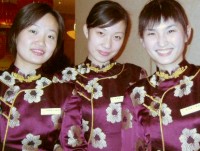
Beijing Hotel restaurant
receptionists | Safe China Welcomes
Tourists With Open Arms  ARS (Severe Acute Respiratory Syndrome) has officially been declared under control and no longer a threat. “The days of SARS outbreak on a large scale are gone,” Xiong Yumei, deputy director general of Beijing Municipal Bureau of Tourism, said in August at the start of my two-week sojourn. ARS (Severe Acute Respiratory Syndrome) has officially been declared under control and no longer a threat. “The days of SARS outbreak on a large scale are gone,” Xiong Yumei, deputy director general of Beijing Municipal Bureau of Tourism, said in August at the start of my two-week sojourn.
Ms. Xiong assured us that the city of Beijing, “because we have learned a lot of lessons and gained valuable experience,” has instituted steps to prevent the disease from returning and to deal immediately with any possible resurgence. 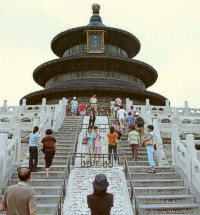
Hall of Prayer for Good Harvests | I wasn’t worried. I found China not only safe but also exhilarating. Its people are prepared to welcome back tourists who came by the millions in previous years. I was here at the invitation of the China National Tourist Administration to witness what is probably the ninth wonder of the world: Three Gorges Dam. First I spent a few fascinating days in the capital of the People’s Republic of China. Although Beijing is invested with 3,000 years of enthralling history, it is a modern metropolis vibrating with efficient subways, advanced telecommunications, gorgeous high-rises and expansive roadways. Furthermore, in anticipation of hosting the Olympic Games 2008, the city has embarked on an ambitious expansion of infrastructure with vast improvements in light-rails, express highways, airports and other tourism undertakings. 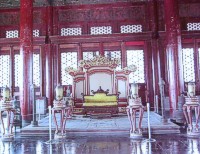
Inside Temple of Middle Harmony
in the Forbidden City | While Beijing reportedly is the world’s fifth most expensive city, I found it to be a shopper’s paradise for the American tourist. With U.S. pressure notwithstanding, the dollar is firmly pegged at 8.12 yuen, making everything downright inexpensive. I was impressed by the main avenues, which are so expansive, with four lanes in both directions. There are separate lanes for bicycles. With a population of 14 million (8 million in the urban area), there are 8 million bikes and 2 million cars. The ubiquitous fast food emporiums of KFC, Pizza Hut, Baskin Robbins, McDonald’s, Hard Rock Cafe and Starbucks add a touch of home influence. As for me, I’d welcome an outpost of the Second Avenue Kosher Deli. 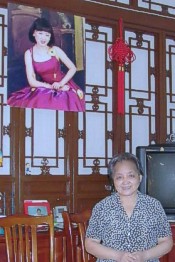
Retired accountant at home
with portrait of granddaughter | My room at the prestigious Beijing Hotel had more than the usual amenities. In addition to the toiletries and hair dryer, there was an item I never encountered before: a gas mask in case of fire. At the breakfast buffet, each item was named on a silver medallion—potatoes, hot cereal, eggs, etc. The nametags on some of the selections had an additional note. The bacon, ham, pork and meat loaf had a warning: “Not for Moslems.” No visit to Beijing is complete without a visit to the Temple of Heaven, Forbidden City, Tiananmen Square and the Great Wall. You don’t have to fear walking anywhere in the city. People are in the main quite friendly and courteous. The Temple of Heaven, built in 1420, is the site of sacrificial ceremonies by the emperors of the Ming and Qing dynasties invoking divine intervention for plentiful rain and bountiful harvest. There are several temples in this complex, the main one being the Hall of Prayer for Good Harvests where sacrifices were made in the spring. Sacrificial rites in China go back thousands of years. 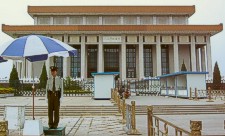
Mao Mausoleum in Tiananmen Square | The Forbidden City, the 600-year-old bastion of mandarin authority, is awesome in its majesty. This city within a city, surrounded by a protective moat, was the home of 24 monarchs of the Ming and Qing dynasties. Bernardo Bertolucci’s Oscar-winning The Last Emperor was filmed here, depicting the fabled Pu Yi’s exit from the palace in 1924. Tiananmen Square, ultimate symbol of the new China, is a spectacular expanse of public domain, the largest public square in the world. Several massive buildings rim the square, including Mao’s Mausoleum, Museum of the Revolution and Great Hall of the People. In China everything’s on a grand scale. 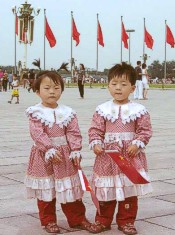
Youngsters in
Tiananmen Square | The Great Wall is certainly a highlight of any visit to Beijing. Although it’s 2,000 years old, most of the masonry wall was built in the Ming Dynasty (1368-1644). The section of the wall I visited is located at Badaling, 61 km north of Beijing. On the outskirts there’s a hotel, restaurants and the requisite souvenir shops. Don’t forget to buy a T-shirt: I Climbed The Great Wall. (They won’t let you forget.) Kempinski Hotel Beijing Lufthansa Center is a must-see site, even if you don’t check in. General Manager Marcus van der Wal arranged for a tour of the magnificent property for a hundred visiting travel writers and tour operators from around the world. Later he hosted an outdoor dinner at the Gong Palace. The Gong Palace is open for foreign tourists to enjoy Beijing Opera in its restaurant theater. That night I saw a combination of opera, acrobatics, sword dancing and kung fu. 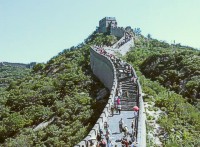
Great Wall of China | Van der Wal, who previously worked for the Inter-Continental in Rio de Janeiro, assured me, “Beijing is the safest place in China. You can go out on the street at three in the morning.” Upcoming reports will focus on Wuhan, Yichang, Three Gorges Dam, Yangtze River, and Shanghai. |